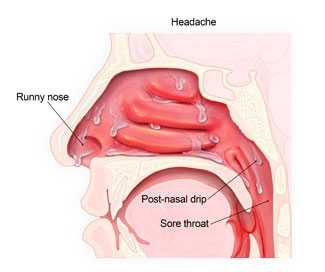Common Cold and Runny Nose
Español: Resfriado común y moqueo
Overview
Antibiotics cannot cure the common cold, one of the most frequent reasons children miss school and adults miss work. Every year, adults have an average of 2–3 colds, and children have even more.
Causes
More than 200 viruses can cause the common cold, and infections can spread from person to person through the air and close personal contact. Antibiotics do not work against these viruses and do not help you feel better if you have a cold. Rhinovirus is the most common type of virus that causes colds.
Risk Factors
 View larger image
View larger image
When you have a cold, mucus fills your nose, causing runny nose, congestion, and mucus to drip down your throat (post-nasal drip), which can cause a sore throat and cough.
There are many things that can increase your risk for the common cold, including:
- Exposure to someone with the common cold
- Age (infants and young children are at higher risk for colds)
- A weakened immune system or taking drugs that weaken the immune system
- Season (colds are more common during the fall and winter)
Signs and Symptoms
When germs that cause colds first infect the nose and sinuses (air-filled pockets in the face), the nose makes clear mucus. This helps wash the germs from the nose and sinuses. After two or three days, mucus may change to a white, yellow, or green color. This is normal and does not mean you or your child needs antibiotics. Other signs and symptoms of the common cold can include:
- Sneezing
- Stuffy nose
- Sore throat
- Coughing
- Post-nasal drip (mucus dripping down your throat)
- Watery eyes
- Mild headache
- Mild body aches
These symptoms usually peak within 2-3 days but can last for up to 10-14 days.
When to Seek Medical Care
See a healthcare professional if you or your child has any of the following symptoms:
- Symptoms that last more than 10 days without improvement
- Symptoms that are severe or unusual
If your child is younger than three months of age and has a fever, it’s important to call your healthcare professional right away.
Diagnosis and Treatment
Antibiotics are not needed to treat a cold or runny nose, which almost always gets better on its own. Your healthcare professional will determine what type of illness you or your child has by asking about symptoms and doing a physical examination. Sometimes they will also swab the inside of your nose or mouth.
Since the common cold is caused by viruses, antibiotics will not help it get better and may even cause harm in both children and adults. Your healthcare professional can give you tips to help with symptoms like fever and coughing.
Symptom Relief
Rest, over-the-counter medicines and other self-care methods may help you or your child feel better. For more information about symptomatic relief, visit the Symptom Relief section of this website or talk to your healthcare professional, including your pharmacist. Remember, always use over-the-counter products as directed. Many over-the-counter products are not recommended for children of certain ages.
Prevention
There are steps you can take to help prevent getting a cold, including:
- Practice good hand hygiene
- Avoid close contact with people who have colds or other upper respiratory infections
- Page last reviewed: March 16, 2016
- Page last updated: March 16, 2016
- Content source:


 ShareCompartir
ShareCompartir